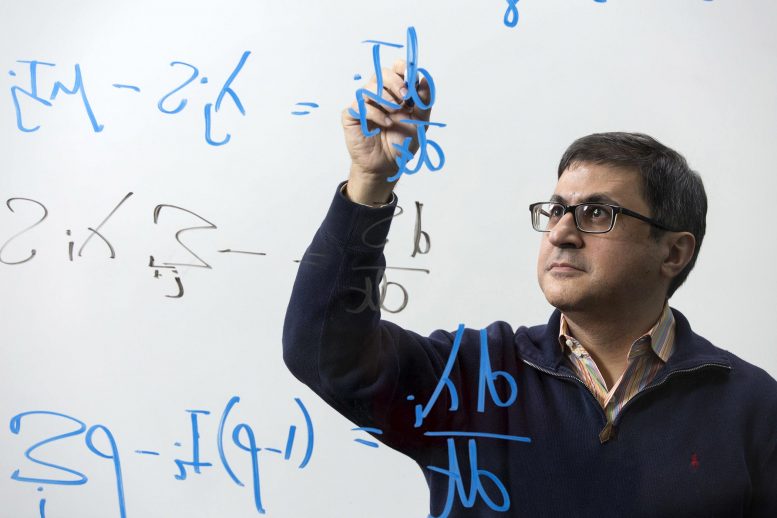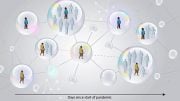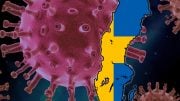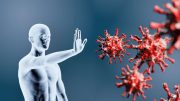
Pejman Rohani sought to determine if and how countries could achieve herd immunity without overburdening the health care system, and to define the control efforts that would be required to do so. Credit: Andrew Davis Tucker/UGA
Results provide insight for public health policymakers fighting COVID-19.
Achieving herd immunity to COVID-19 is an impractical public health strategy, according to a new model developed by University of Georgia scientists. The study recently appeared in Proceedings of the National Academy of Sciences.
Controlling COVID-19 has presented public health policymakers with a conundrum:
How to prevent overwhelming their health care infrastructure, while avoiding major societal disruption? Debate has revolved around two proposed strategies. One school of thought aims for “suppression,” eliminating transmission in communities through drastic social distancing measures, while another strategy is “mitigation,” aiming to achieve herd immunity by permitting the infection of a sufficiently large proportion of the population while not exceeding health care capacity.
“The herd immunity concept is tantalizing because it spells the end of the threat of COVID-19,” said Toby Brett, a postdoctoral associate at the Odum School of Ecology and the study’s lead author. “However, because this approach aims to avoid disease elimination, it would need a constant adjustment of lockdown measures to ensure enough—but not too many—people are being infected at a particular point in time. Because of these challenges, the herd immunity strategy is actually more like attempting to walk a barely visible tightrope.”
This study carried out by Brett and Pejman Rohani at the University of Georgia’s Center for the Ecology of Infectious Diseases, investigates the suppression and mitigation approaches for controlling the spread of SARS-CoV-2, the virus that causes COVID-19.
While recent studies have explored the impacts of both suppression and mitigation strategies in several countries, Brett and Rohani sought to determine if and how countries could achieve herd immunity without overburdening the health care system, and to define the control efforts that would be required to do so.
They developed an age-stratified disease transmission model to simulate SARS-CoV-2 transmission in the United Kingdom, with spread controlled by the self-isolation of symptomatic individuals and various levels of social distancing.
Their simulations found that in the absence of any control measures, the U.K. would experience as many as 410,000 deaths related to COVID-19, with 350,000 of those being from individuals aged 60-plus.
They found that using the suppression strategy, far fewer fatalities were predicted: 62,000 among individuals aged 60-plus and 43,000 among individuals under 60.
If self-isolation engagement is high (defined as at least 70% reduction in transmission), suppression can be achieved in two months regardless of social distancing measures, and potentially sooner should school, work and social gathering places close.
When examining strategies that seek to build herd immunity through mitigation, their model found that if social distancing is maintained at a fixed level, hospital capacity would need to greatly increase to prevent the health care system from being overwhelmed. To instead achieve herd immunity given currently available hospital resources, the U.K. would need to adjust levels of social distancing in real time to ensure that the number of sick individuals is equal to, but not beyond, hospital capacity. If the virus spreads too quickly, hospitals will be overwhelmed, but if it spreads too slowly, the epidemic will be suppressed without achieving herd immunity.
Brett and Rohani further noted that much is unknown about the nature, duration and effectiveness of COVID-19 immunity, and that their model assumes perfect long-lasting immunity. They cautioned that if immunity is not perfect, and there is a significant chance of reinfection, achieving herd immunity through widespread exposure is very unlikely.
“We recognize there remains much for us to learn about COVID-19 transmission and immunity, but believe that such modeling can be invaluable in so-called ‘situational analyses,’” said Rohani. “Models allow stakeholders to think through the consequences of alternative courses of action.”
Reference: “Transmission dynamics reveal the impracticality of COVID-19 herd immunity strategies” by Tobias S. Brett and Pejman Rohani, 22 September 2020, Proceedings of the National Academy of Sciences.
DOI: 10.1073/pnas.2008087117
Pejman Rohani is the Regents’ and UGA Athletic Association Professor in Ecology and Infectious Diseases in the Odum School of Ecology and department of infectious diseases, College of Veterinary Medicine. Tobias Brett is a postdoctoral research associate in the Rohani lab. Research reported in this news article was supported by the National Institute of General Medical Sciences of the National Institutes of Health through a MIDAS (Models of Infectious Disease Agent Study) Program grant under award No. 5R01GM123007. The content is solely the responsibility of the authors and does not necessarily represent the official views of the National Institutes of Health.








“while another strategy is “mitigation,” aiming to achieve herd immunity” – WRONG, mitigation does not imply herd immunity.
-Why do you arrange the different groups in different ways? (spoiler – marketing)
“Their simulations found that in the absence of any control measures, the U.K. would experience as many as 410,000 deaths related to COVID-19” – total deaths
“They found that using the suppression strategy, far fewer fatalities were predicted: 62,000 among individuals aged 60-plus and 43,000 among individuals under 60.” – separating total deaths in two groups
“If self-isolation engagement is high (defined as at least 70% reduction in transmission)” (- lol you present no info how to get to that 70% reduction, self isolation on itself would never achieve that rate) “suppression can be achieved in two months regardless of social distancing measures, and potentially sooner should school, work and social gathering places close.” – again, saying that if we could achieve 70% reduction in transmission, we could do this and that and that, IF..
Also why using the word suppression over and over with different meanings (1- “suppression,” eliminating transmission in communities through drastic social distancing measures; 2- suppression of the virus/epidemic as a consequence of all measures)
Besides that, the entire data of the number of cases is BS; Way more people have been infected, some antibody studies easily tell you that, and even those are heavily underestimated due to low antibody count (counts as negative test), antibody progressive diminution in people, and most people don’t even develop antibodies because the unspecialized immunity system (innate immunity) takes care of it.
I could go on with this for hours…
You can’t simply run models based on wrong data and expect for people to fall into this false science. Regular people see this data and compare it to their real world perception.
Model says no herd immunity practical but the reality of the numbers dying shows that herd immunity had already been reached by the end of April in the UK due to most people having some immunity to “novel” corona due to the common cold that is endemic around the world. This anti-science article based on rubbish in and rubbish out of incomplete models is destroying real science and should have no place in any real science publication. Utterly disgraceful.
… Okay, I guess somebody has decided to put it on the paper.
To actually calculate how many people needs to die in a short period of time, and how many hospitals need to get over crowded and how many industries will come to grinding halt, and all that to reach the 60-80% of people with resistance to a Covid.
Well, did they use simulation in order to calculate that, or a calculator. Yeah, flat curve saves the society, thada…